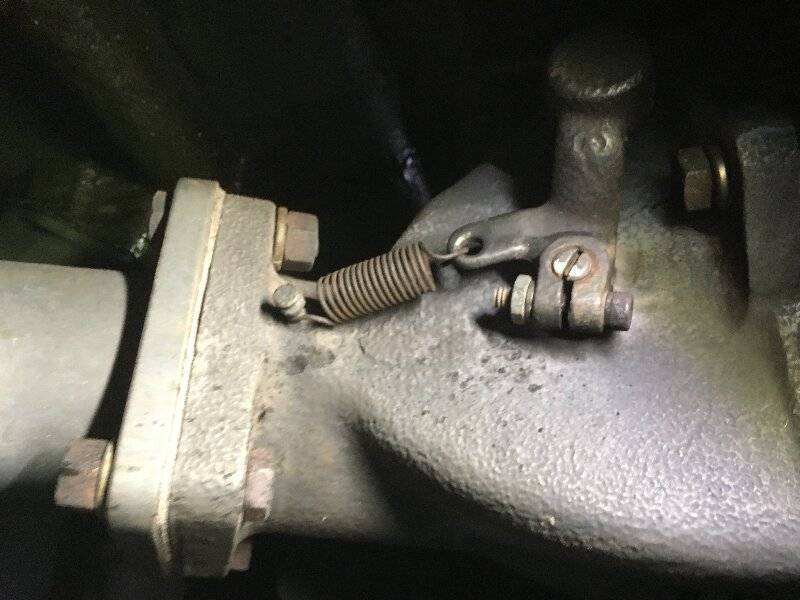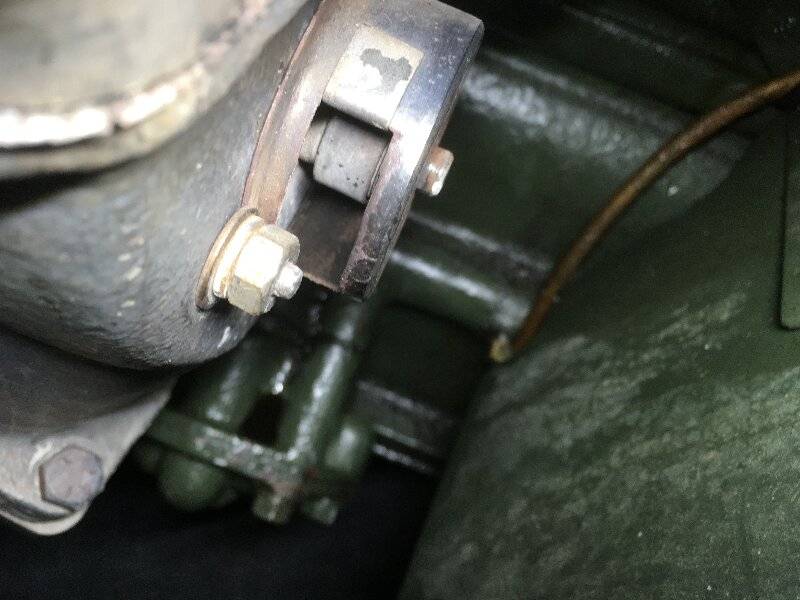Re: The Duchess Project: 1940 Super 8 Convertible Sedan
Posted by Joe Santana On 2021/1/24 9:44:00
I dove into the manual and the first item to check on percolating and flooding is the Heat Control Valve.
HEAT CONTROL VALVE: The valve shaft has to be free to move. There are instructions for lubricating it, but not with oil. The thermostatic spring on the front side couldn't hold the valve closed because the counter weight on the back side was positioned too high, blocking the valve from rotating all the way clockwise to the closed position, which directs warm exhaust up to the riser hot box on which the carburetor is mounted. I loosened it from the shaft, rotated the shaft clockwise until the valve closed and reset the counter-weight at about 10 o'clock.
HEAT CONTROL VALVE ADJUSTMENT
I can find no instructions for setting the heat control valve, but I would do this (PLEASE correct me if this is incorrect!), if, when grasping the counterweight on the rear side of the manifold box, the shaft rotates easily to both the closed (clockwise) and open positions:
1. When the engine is cold, the heat control valve should be closed; that is, the shaft it is mounted on is turned, from the rear perspective, all the way clockwise.
2. To set the valve in the closed position,
a. on the rear side of the manifold box, loosen the set screw holding the counterweight, it’s not necessary to disconnect the anti-rattler spring.
b. on the front side of the manifold box, loosen the retaining nuts which hold the bimetallic thermostatic spring-retainer cover just enough to turn the cover counter-clockwise, tightening the spring tension, until the valve is held closed with minimum tension. Then tighten the retaining nuts.
c. Now, with the valve held all the way closed by the thermostatic spring, the counterweight on rear side of the manifold box should be positioned as high as it will go. Hold it in that position by tightening the set screw. Reconnect the anti-rattler spring if it was disconnected.
3. The bi-metallic spring on the front side of the exhaust manifold box holds the valve closed while the manifold warms up. When closed, the valve diverts hot exhaust flow up and around the manifold riser hot box, on which the carburetor is mounted, to warm gas and facilitate a smoother engine start and warm-up.
4. As the engine exhaust warms the manifold, it heats the thermostatic spring causing it to expand/relax and turn the valve shaft (from the rear perspective, counter-clockwise) to open the valve midway, allowing more exhaust to exit directly and bypass the hot box.
5. The counterweight aids in this opening of the valve and therefore moves counter-clockwise from its starting position at the top to a lower position.
6. When the engine is at normal operating the temperature, the spring opens the valve all the way, preventing exhaust from entering the upper riser hot box where the carburetor is mounted and sending it all out the tailpipe.
Attach file:
 heatvalverear.JPG (192.83 KB)
heatvalverear.JPG (192.83 KB)

 heatvalvefront.JPG (181.81 KB)
heatvalvefront.JPG (181.81 KB)

 HeatControlValveIllus.jpg (124.37 KB)
HeatControlValveIllus.jpg (124.37 KB)

HEAT CONTROL VALVE: The valve shaft has to be free to move. There are instructions for lubricating it, but not with oil. The thermostatic spring on the front side couldn't hold the valve closed because the counter weight on the back side was positioned too high, blocking the valve from rotating all the way clockwise to the closed position, which directs warm exhaust up to the riser hot box on which the carburetor is mounted. I loosened it from the shaft, rotated the shaft clockwise until the valve closed and reset the counter-weight at about 10 o'clock.
HEAT CONTROL VALVE ADJUSTMENT
I can find no instructions for setting the heat control valve, but I would do this (PLEASE correct me if this is incorrect!), if, when grasping the counterweight on the rear side of the manifold box, the shaft rotates easily to both the closed (clockwise) and open positions:
1. When the engine is cold, the heat control valve should be closed; that is, the shaft it is mounted on is turned, from the rear perspective, all the way clockwise.
2. To set the valve in the closed position,
a. on the rear side of the manifold box, loosen the set screw holding the counterweight, it’s not necessary to disconnect the anti-rattler spring.
b. on the front side of the manifold box, loosen the retaining nuts which hold the bimetallic thermostatic spring-retainer cover just enough to turn the cover counter-clockwise, tightening the spring tension, until the valve is held closed with minimum tension. Then tighten the retaining nuts.
c. Now, with the valve held all the way closed by the thermostatic spring, the counterweight on rear side of the manifold box should be positioned as high as it will go. Hold it in that position by tightening the set screw. Reconnect the anti-rattler spring if it was disconnected.
3. The bi-metallic spring on the front side of the exhaust manifold box holds the valve closed while the manifold warms up. When closed, the valve diverts hot exhaust flow up and around the manifold riser hot box, on which the carburetor is mounted, to warm gas and facilitate a smoother engine start and warm-up.
4. As the engine exhaust warms the manifold, it heats the thermostatic spring causing it to expand/relax and turn the valve shaft (from the rear perspective, counter-clockwise) to open the valve midway, allowing more exhaust to exit directly and bypass the hot box.
5. The counterweight aids in this opening of the valve and therefore moves counter-clockwise from its starting position at the top to a lower position.
6. When the engine is at normal operating the temperature, the spring opens the valve all the way, preventing exhaust from entering the upper riser hot box where the carburetor is mounted and sending it all out the tailpipe.
Attach file:
 heatvalverear.JPG (192.83 KB)
heatvalverear.JPG (192.83 KB)
 heatvalvefront.JPG (181.81 KB)
heatvalvefront.JPG (181.81 KB)
 HeatControlValveIllus.jpg (124.37 KB)
HeatControlValveIllus.jpg (124.37 KB)
This Post was from: https://packardinfo.com/xoops/html/modules/newbb/viewtopic.php?post_id=229698